| What's
all the Hub-bub about? |
| If
someone were to tell you that you had an 83% chance
of keeping all the hair you currently have today by
taking one pill one time a day, would you do it?
With a Prop (finasteride)
prescription, it's not only a possibility, it's becoming
a reality for hundreds of thousands of men.
Rather than fill your
brain with all the medical jargon, we are going to
give you in layman's terms exactly how this treatment
works, how well it works, what its side
effects are, and where you can buy it.
|
The Study
Merck conducted a two year clinical trial,
in which 1,553 men ages 18 to 41 with mild to moderate thinning /
balding at the top of the
head took this treatment daily. At the 2 year mark, 83% of them had maintained their hair (based on hair count) and 66% of
them had experienced regrowth. A side assessment by the doctors in the study rated 80% of men as improved, at the end of the period.
|
Complete
Documentation on the 2 Year Trials
|
|
To get Adobe
Acrobat click here:

|
To view the
PDF document click here:
 Propecia
2 Year Trials
Propecia
2 Year Trials
|
Merck also had its trial patients
use an anti-inflammatory shampoo called T-Gel during the 2 year
trials. This was
to eliminate any development of Seborrheaic Dermatitis, an itching
and flaking of the skin. This is a very common occurrence in men experiencing balding,
and can very much ruin the chances of any treatment's success.
Nizoral has been shown to be even more effective and is available
in your grocery store shampoo section. For studies related
to Nizoral, you can visit our Document Resource Center and look in
the "Nizoral Related" section by clicking HERE.
Other shampoo's like Tricomin
work extremely well in helping the scalp stay in
balance.
|

The molecular structure of
Finasteride
|
What does this mean for you?
So how does all of this relate to
your situation. Well, let's look at what Finasteride, its
active ingredient, does.
As we have established, DHT plays a major role in why
you're losing your hair.
This hair loss treatments claim to fame is
enabling you to maintain your current hair count.
It is not typically used by itself as a hair growth stimulant,
however 66% did see regrowth using it.
|
When a man starts to undergo the
process of losing his hair, he already has DHT in his
system. It has enabled him to successfully develop as a
fetus, and to successfully get through puberty. The change
that occurs is that certain follicles on the head are genetically
programmed to begin developing DHT receptor sites. The DHT
attaches itself to these receptor sites and begin to treat the
follicle as a foreign object in the body. It is at this
point that the sebum production can tend to increase, and Seborrheaic
Dermatitis can develop, manifesting itself as itching, flaking,
redness, and inflammation. This is why Nizoral is such an
imperative part of your regimen. It controls this aspect of
the problem. During this time the follicle, under the attack
of DHT, begins to miniaturize with every growth cycle, until after
several years, it simply is too small and short to be seen.
Propecia deals with this whole process by reducing the development
of DHT in the system, which in turn means less DHT attaching to
the receptor sites in the follicles, which in turn means less
inflammation, itching, and miniaturization, which in turn results
in a reduced rate of hair loss.
| |
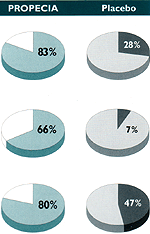
|
Caution!
I cannot stress this enough - it may be very tempting to start
dumping things on your head and popping pills to stop your balding.
It is
strongly suggested that you try one treatment at a time because
the minute you start a regimen, you will be on it for the rest of
your life.
If you can have good results with Prop alone,
then you've saved yourself a *lot* of time and money.
If
not, you can always add things one by one. |
| Percentage
of men who maintained or increased their hair count. |
| Percentage
of men who had visible hair regrowth, as determined by an
independent panel of dermatologists |
| Percentage
of men rated as improved by clinical doctors |
It really all depends on what your
goal is. Some of you may be young and just starting to
notice fallout. Do you want to arrest that fallout?
Then this treatment may be for you. Do you want to regrow hair?
Then combining it with another treatment such as Minoxidil may
be your best bet. Giving it a good 6
months of daily use is a smart idea. As stated before, Minoxidil and
Propecia together are one of the most potent hair loss and
balding regimen's available today.
|
Want
proof? Just take a look at Jon Ross's pictures: |
| Before
Prop & Minoxidil

|
After
Prop & Minoxidil

|
Email
Jon at res03hsp@gte.net
You can also view his full Bio here: Jon
Ross |
Before we go screaming ahead -
let's look again at what exactly happens when you take Finasteride.
Simply put, it blocks the formation of
DHT. DHT is in your blood, and in your scalp. Some
treatments try to block DHT in the scalp via a Topical application
(Revivogen,
Tricomin,
etc.). Propecia blocks the formation of DHT in your blood,
which in turn, over time, affects the DHT levels in your scalp. Testosterone and another hormone known as 5-Alpha
Reductase combine to create DHT. What does all this
mean? It means if you stop the two from binding, you're
going to have a little extra Testosterone floating around in your
system. Specifically about 9% more.
This means that at first, you may experience small
temporary changes such as oily skin, zits, and a slightly increased
sex drive. Some have even reported better results in their muscle
development after working out. On the downside, some men experience decreased libido up front, or after the temporary increase in libido due to the extra
Testosterone. Your body tries to adjust to the changes going on, so there are fluctuations, however after a few weeks you should level out again.
Typically, only some men experience about a week or two of
slightly lowered
libido.
NOTE! Propecia does NOT cause Impotence!
Lowered Libido is very different from impotence.
Softer erections have been reported but this happened in about 2%
of men. Those who experienced it simply end up thinking about sex *less* often for a period of time.
There have been no reports of men being unable to function
sexually, however. This is a common misconception about this
hair loss treatment.
First Steps...
So what do you do in light of
this? For most men, side effects are not even an issue, but how can you be
sure....?
Helpful
Hint
Go to your doctor or dermatologist. Ask them for a
15 day trial pack. They come in silver sheets like the ones pictured to the
right and are FREE. Nearly every
dermatologist will have some there for you. Take the
treatment for 15 days. If you see side effects that
you feel are unbearable, then just simply stop the
treatment. Most places you can buy propecia will have
these.
|
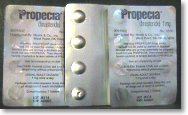 |
Nearly every man who experienced
side effects said that they were so mild, they never considered stopping.
| What? I'm
going to lose more? |
|
One thing to note is that you may experience a
"shedding" period during the first three months of
treatment. This can be extremely maddening, but it is a sign
that the treatment is working. One man said he shed for
almost 3 months. Then, like a charm, the whole thing
stopped. He saw 75 new hairs sprout along his hair line and
his hair thickened right back up to where it was when he first
started, only to stay that way
for many many months down the road. This seems to be a
common occurrence.
When Finasteride enters your
system, it immediately stops the formation of DHT. The
follicles being affected by DHT in any fashion seem to fall out
slowly, and as they begin to recycle again into stronger
follicles, they grow back. Don't lose hope, this is normal!
Propecia
and the Front-Top of the Head
The following photos
show a subset of the results across each different type of
responsiveness for those who were losing hair in the Anterior
Mid-Scalp region. These photos were taken from the actual 2
year Propecia FDA conducted trials. To view the actual study
regarding frontal hair loss and Propecia, check it out in the
document resource center in the "Propecia Related" section
by clicking HERE.
| RESULTS (Month 24) |
Start
of Treatment |
Month
6 |
Month
24 |
|
4%
of men on PROPECIA
had moderate improvement |
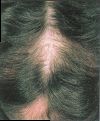 |
 |
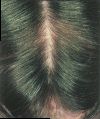 |
|
38%
had
slight improvement |
 |
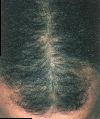 |
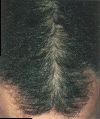 |
|
53%
had
no visible hair loss |
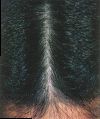 |
 |
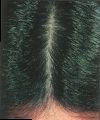 |
The following numbers
represent an assessment on a visual level only, by certified
dermatologists after patients had been on Propecia for 1 year and 2
years. Please do not confuse these with actual hair counts,
which showed 66% improvement and 83% stoppage of hair loss at 2
years.
|
In global
photographic assessment at 12 Months:
4% showed moderate
improvement
34% showed slight improvement
62% showed a stoppage of hair loss
1% showed continued hair loss |
In global
photographic assessment at 24 Months:
42% showed slight or
moderate improvement
53% showed a stoppage of hair loss
5% showed continued hair loss
|
| Propecia
and the Top-Back of the Head |
|
The following photos
show a subset of the results across each different type of
responsiveness for those who were losing hair in the Vertex
region. These photos were taken from the actual 2 year
Propecia FDA conducted trials.
| RESULTS (Month 24) |
Start of Treatment |
Month 6 |
Month 24 |
|
| 5%
of men on PROPECIA had great improvement |
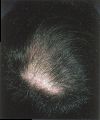 |
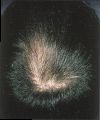 |
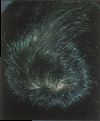 |
|
| 31%
had moderate improvement |
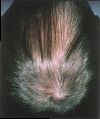 |
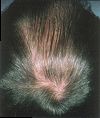 |
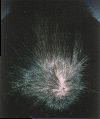 |
|
| 30%
had slight improvement |
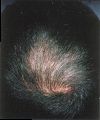 |
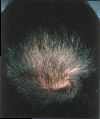 |
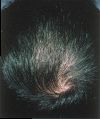 |
| Effectiveness
of Propecia |
Effectiveness
of Placebo |
66%
showed improvement
33% no visible hair loss
1% visible hair loss |
7%
showed improvement
60% no visible hair loss
33% visible hair loss |
Expected Timeline
What should you expect upon taking
that first pill? Below is an example of a *worst case* scenario.
As stated above most men never experience any of these side
effects. Here's the good and the bad, in a nice convenient
timeline:
-
Week 1-2: Possible
increased sex drive, slightly oily skin, possible light zits,
increased shedding (normal!)
-
Week 3-5: 4% of men may
experience a slight decrease in sex drive
-
Week 6-?: Side effects
dissipate, possible continued shedding until month 3 or 4
This is of course assuming you
experience any in the first place. It is entirely dependant
upon the person.
-
Month 3 or 4: Good
Responders - You may see a stoppage in shedding
Slow Responders - Give it 6 months to a year.
-
Month 6 or 8: Good
Responders - You may see additional regrowth.
Slow Responders - may take up to a year or may not see regrowth
at all, just maintenance of hair count.
NOTE: Treatment takes
time. It may be up to 12 months before you see a stoppage of
balding, let alone regrowth, so stick with it. If after 1 year
of treatment you do not see any such results, it is unlikely
to be effective for you.
|
